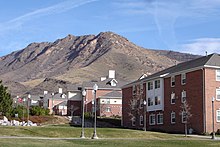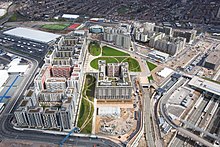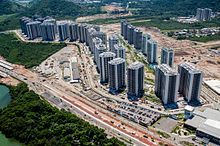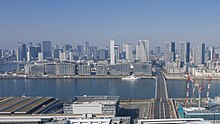Olympic Village

An Olympic Village is a residential complex built or reassigned for the Olympic Games in or nearby the host city for the purpose of accommodating all of the delegations. Olympic Villages are usually located close to the Olympic Stadium within an Olympic Park.[1]
Olympic Villages are built to house all participating athletes during the two weeks of the Games, as well as officials and athletic trainers.[1] After the Games are over, the Olympic Village is typically sold or rented to the local population and turned into a new residential zone for the host city.
The accommodation provided for the 1932 Summer Games in Los Angeles is considered to be the first official modern Olympic Village,[1] and the first permanent Olympic Village was established at the 1952 Summer Olympics in Helsinki, Finland.
After the Munich massacre at the 1972 Olympics, the Villages have been made extremely secure. Only athletes, trainers and officials are allowed to room at the Village, though family members and former Olympic athletes are allowed inside with proper checks. Press and media are also barred.
History

For the first editions of the modern Olympic Games, between 1896 and 1920, there were no official living arrangements for athletes. Some athletes stayed in hotels or hostels, others in schools or barracks, and some even slept in the boats they had taken to the host city.[2]
The prototype for the Olympic Village comes from Pierre de Coubertin, then president of the International Olympic Committee. The "General Technical Rules" applicable to the 1924 Summer Games in Paris stipulated that "The Organising Committee for the Olympic Games is required to provide the athletes with accommodation, bedding and food, at a fixed rate which shall be set beforehand per person and per day…."[3]
As result, the organizers built wooden huts and established an accommodation centre near the Stade Olympique de Colombes called the "Olympic Village," allowing the various world teams to stay in the same location, under the same conditions, and with common services.[3]
Consideration was given to creating an Olympic Village ahead of the 1928 Games in Amsterdam, but the organizers opted for other solutions.[3]

The accommodation provided for the 1932 Summer Games in Los Angeles is considered to be the first official modern Olympic Village, with a capacity of 2,000 people and located to the west of the city.[1][3] Consisting of a group of buildings with rooms to lodge athletes (men only), as well as providing a place to eat and train, it serves as the model for today's Olympic Villages. It also provided certain community services for the first time, including a hospital, a fire station, and a post office.[2]
Following the 1932 Games, a Village would be created for every edition of the Summer Games, apart from the 1948 London Games due to material challenges brought on by the immediate post-war period. For the Winter Games between 1924 and 1956, the teams would still mainly stay in hotels, with the exception of the 1952 Games in Oslo, where three accommodation sites were created.[3]
Women, on the other hand, stayed in other accommodation sites until 1952. This changed with the Melbourne Games of 1956, where women had their own part of the main Olympic Village.[2] This area of the Village would not admit male athletes, and it was only from the 1984 Games in Los Angeles onward that athletes were accommodated by team rather than gender.[3]
The first permanent Olympic Village was established at the 1952 Summer Olympics in Helsinki, Finland.[3]
After the Munich Massacre at the 1972 Olympics, the Villages have been made extremely secure.
List of Olympic Villages
Prototype complexes:
- Athens 1906 (Intercalated Games): The Zappeion, which was used during Athens 1896 as the main Fencing Hall, was used in 1906 as a (not purpose-built) Olympic Village.[5]
- Paris 1924: In Paris in 1924, a number of cabins were built near the stadium to house visiting athletes; the complex was called "Olympic Village".[6]
Official Olympic Villages
- Los Angeles 1932: An Olympic Village was built for the first time in Baldwin Hills, occupied by male athletes. It consisted of several hundred buildings, including post and telegraph offices, an amphitheater, a hospital, a fire department, and a bank. Female athletes were housed at the Chapman Park Hotel on Wilshire Boulevard.[7][8][9]

- Berlin 1936: About 145 one- and two-story apartment buildings, Haus der Nationen refectory, Hindenburghaus theater, a hospital, an indoor arena, a swimming pool and a sauna in Wustermark about 9.5 kilometres west of Berlin. Used as barracks for over 50 years, the buildings are partially ruined. A men's residence has been restored under the name "Jesse Owens house".
- Helsinki 1952: The first Olympic Village, Olympiakylä, was constructed in the Käpylä district of Helsinki for the planned 1940 Summer Olympics, which were cancelled due to World War II. Another Olympic Village, Kisakylä, was built nearby for the 1952 Olympics. Kisakylä couldn't accommodate all athletes so other villages were also designated for instance in Otaniemi and the Santahamina military base. Both Olympiakylä and Kisakylä areas are listed by Docomomo as significant examples of modern architecture in Finland.[10][11]

- Melbourne 1956: The area in Heidelberg West, Victoria, where the athletes stayed is still called "Olympic Village". After the games, athlete residences were used for public housing. The area now consists of a sports center, a primary school, shopping strip, a community health centre which also houses a registered training organization and a legal service.
- Squaw Valley 1960: Four identical three-story apartment buildings, two of which still stand, modified into condominiums.
- Rome 1960: consist of 33 buildings with two, three, four and even five floors.
- Innsbruck 1964 and 1976: A two phases housing buildings at Neu Arzl Olympic Village district.
- Tokyo 1964: Main village in Yoyoki, with 4 other satellite village in Tokyo.[12]
- Mexico City 1968: 904 apartments distributed in 29 multi-story buildings in the Miguel Hidalgo Olympic Village Complex.
- Munich 1972: Multiple buildings of 25, 22, 20, 19, 16, 15, and 12 stories, used now as Olympic Village student housing.

- Montreal 1976: Olympic Village (Montreal) consists of two 23-story pyramid-shaped buildings, which are now apartment buildings.
- Lake Placid 1980: Later converted into a Federal Prison FCI Ray Brook.
- Moscow 1980: Eighteen 16-story buildings.
- Sarajevo 1984: Apartment buildings now used as condominiums and tourist facilities.
- Los Angeles 1984 and 2028: The UCLA residents' facilities, CSULA, USC, and UCSB.
- Calgary 1988: Presently student accommodations on the campus of the University of Calgary. The athlete's village consisted of the existing Kananaskis, Rundle, Castle, Norquay and Brewster buildings, as well as the newly constructed Glacier and Olympus buildings.
- Seoul 1988: Twenty-one multiple-story buildings located in Jamsil.
- Albertville 1992: Brides-les-Bains
- Barcelona 1992: A new neighbourhood, La Vila Olímpica, was built on reclaimed sea front in Poblenou; it became residential after the Games. Secondary villages were built in Banyoles and La Seu d'Urgell for rowing and white water canoeing athletes respectively.[13]
- Lillehammer 1994: The village was built on a west-facing slope just to the north of Lillehammer, and took its form from the old farms of Gudbrandsdal.

Plaque recognizing Georgia Tech as the site of the 1996 Olympic Village - Atlanta 1996: Housing was built on the campus of Georgia Institute of Technology, Clark Atlanta University, and Georgia State University. The Olympic village at Georgia State was later bought by Georgia Tech for students' housing. The village on the campus of Clark Atlanta, later became housing for students at CAU.
- Nagano 1998: The village is located 7 kilometers southwest of Nagano Station. The total land space is 19 hectares. There are 1032 apartments in 22 buildings, and is capable of accommodating 3,000 people. A secondary Village was in Karuizawa, the site for the newly entered Olympic sport of curling. Karuizawa is about 70 kilometers southeast of Nagano City. 120 people from 9 countries stayed at the Karuizawa Skate Center Hotel during the Winter Games.
- Sydney 2000: A new suburb, Newington, which became residential following the Games.

- Salt Lake City 2002: Housing from the University of Utah and Fort Douglas (located on the campus).
- Athens 2004: A new suburb composed of four- to five-story apartments in the Parnitha area located in northeast Athens adjacent to Maroussi, the suburb where the OAKA complex, is located. The Athens Olympic Village also became a residential area following the Games. Today, the village with a capacity of approximately 10,000 people is in use.
- Turin 2006: The three Olympic Villages were located in the city of Turin and in the towns of Bardonecchia and Sestriere.
- Beijing 2008: Beijing 2008 Olympic Village Twenty-two 6-story buildings and twenty 9-story buildings (for Beijing Venue); Royal Park Hotel (for Hong Kong venue).
- Vancouver 2010: Vancouver Olympic Village and Whistler Olympic and Paralympic Village.
- Singapore 2010 (Youth): Campus of the Nanyang Technological University.

- London 2012: The residential area at East Village.

- Sochi 2014: Two Olympic Villages: Coastal Olympic Village and Mountain Olympic Village
- Lillehammer 2016 (Youth): Two villages, the main Lillehammer (the Birkebeineren Hotel) and one in Hamar (the 239-room Hotel Scandic Hamar).
- Rio de Janeiro 2016: A complex of new buildings at Barra da Tijuca neighboured near to City of Sports Complex.
- Pyeongchang 2018: Pyeongchang Olympic Village
- Buenos Aires 2018 (Youth): Youth Olympic Village , 1,440 existent apartments in seven-story buildings in the district of Villa Soldati, within the limits of the City Park.

- Lausanne 2020 (Youth): The Vortex building located in the heart of the campus of the University of Lausannee, 952 rooms, 9 floors. Converted into student apartments after the Games.
- Tokyo 2020: Located in Harumi, an island district of Chūō, Tokyo (central Tokyo). The Harumi Futo village had 21 residential buildings with over 5,000 units.There are also two satellite villages, one in Saitama near the track cycling and another in Enoshima for sailing.
- Beijing 2022: Three new building complexes; the first at Beijing's Olympic Green and Yanqing District district and another one at co-host city Zhangjiakou.
- Paris 2024: The village is 7 kilometres (4.3 mi) north of the Paris central business district in the communes of Saint-Denis, L'Île-Saint-Denis and Saint-Ouen-sur-Seine.[14] This allows 85% of athletes to be within thirty minutes from their competition venues.
- Milan-Cortina 2026: The Milan Olympic Village is being built at the Scalo Porta Urbana district. The Cortina Olympic Village is also planned to be built in Fiame, a small village located around five kilometres from the centre of Cortina d'Ampezzo. Another two villages were planned near the Valtellina and Val di Fiemme clusters.
- Brisbane 2032: Northshore Hamilton[15]
References
- ^ a b c d "Competing and being part of the Games Archived 2023-05-11 at the Wayback Machine." 2021 International Olympic Committee. Retrieved 2023-04-28.
- ^ a b c The Olympic Museum Educational and Cultural Services. 2013. "The Modern Olympic Games Archived 2023-04-29 at the Wayback Machine." The Olympics Museum. Retrieved 2023-04-28.
- ^ a b c d e f g "Olympic Summer Games Villages from Paris 1924 to Tokyo 2020 Archived 2023-04-29 at the Wayback Machine." The Olympic Studies Centre. 2022 June 20.
- ^ "As East and West Prepare for Olympic Classic at Los Angeles Next Summer". The Pittsburgh Press. 1 May 1932. p. 25. Retrieved 1 December 2023.
- ^ "The Zappeion Exhibition Hall over time". The Zappeion Megaron Hall of Athens. Archived from the original on 2008-09-21. Retrieved 2008-11-11.
- ^ "Olympic Village (village, Olympic Games) - Encyclopædia Britannica". Britannica.com. Archived from the original on 2014-02-28. Retrieved 2014-02-17.
- ^ 1932 Los Angeles Olympic Athlete's Village in the Baldwin Hills Archived 2012-04-26 at the Wayback Machine, Accessed November 12, 2007.
- ^ 1932 Los Angeles Olympic Athlete's Village in Baldwin Hills Archived 2012-04-26 at the Wayback Machine, Accessed November 12, 2007.
- ^ "1932 Los Angeles Olympic Athlete's Village - Baldwin Hills- Baldwin Hills Information". Archived from the original on 2020-12-08. Retrieved 2020-11-28.
- ^ "Olympiakylä – Olympic village". Docomomo Suomi Finland ry. Archived from the original on March 9, 2014. Retrieved March 8, 2014.
- ^ "Kisakylä – Olympic 1952 Village". Docomomo Suomi Finland ry. Archived from the original on March 9, 2014. Retrieved March 8, 2014.
- ^ "選手村" (in Japanese). 日本オリンピック委員会. Archived from the original on 2021-06-21. Retrieved 2021-07-03.
- ^ "Barcelona 1992 Official Report" (PDF). Archived from the original (PDF) on May 28, 2008.
- ^ "The Olympic and Paralympic Village". Paris 2024. 11 March 2019. Archived from the original on 11 January 2021. Retrieved 19 December 2020.
- ^ Dennien, Matt (2021-07-28). "First look at Brisbane's 2032 Olympics athletes' village". Brisbane Times. Archived from the original on 2021-08-09. Retrieved 2021-08-09.
External links
 Media related to Olympic villages at Wikimedia Commons
Media related to Olympic villages at Wikimedia Commons
- ^ "Paris 2024 Olympic Village: Location, Map & Complete Guide". Sporting Tribe. Waleed.K. 29 July 2024. Retrieved 29 July 2024.
